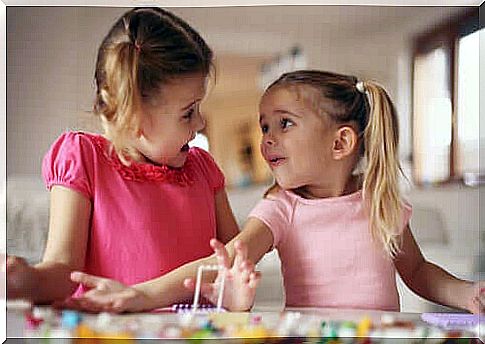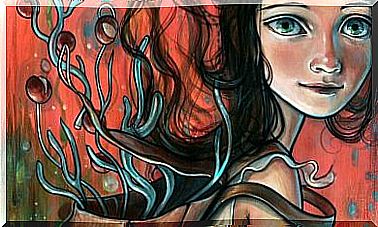The Development Of Empathy In Childhood

Before explaining the development of empathy in childhood, let us trace the origin of this term.
The origin of the concept “empathy” derives from what the Scottish Enlightenment philosophy called “sympathy”. David Hume, in their treatise on human nature, and Adam Smith describe it as a natural means of communication.
It is this definition that will be used as a basis in neuroscience, developmental psychology and social psychology. The development of empathy in childhood provided very curious facts about evolutionary aspects as a species.
One idea stands out: our socialization is not originally due to empathy. The biology of evolution shows us that altruistic behavior arose before the acquisition of this potentiality.
Some species that lack empathy exhibit such behaviors. This is the case with social insects such as bees that, dying shortly after stinging their target, sacrifice themselves to protect the swarm. The link between empathy and altruism is not a simple one.

The focus of developmental psychology
Lipps’ (1903) work focused on the difference between the terms sympathy and empathy. Developmental psychology researchers have defined the concept of empathy as a multidimensional construct, taking into account the cognitive component .
This includes recognizing and understanding the emotions of others and the emotional component, which is sharing the affect or indirect response.
Cognitive models
On the other hand, since the 1990s, empathy has been studied based on emotional intelligence, highlighting, in the first place, the model of Mayer and Salovey (1997).
Empathy is seen as an element that includes the perception of others’ emotions, as well as the understanding of one’s own emotions.
Another relevant model was Bar-On’s (1997, 2000) socio-emotional intelligence model. He proposes that empathy is a component of a factor called interpersonal skills, and is seen as the ability to be aware and understand the emotions, feelings and ideas of others.
These two models are not as integrative as those proposed in developmental psychology. In them, there is no space for the emotional component, focusing more on the cognitive component.
Most current proposal
Today, Batson and colleagues have proposed a distinction between perspective taking and empathy. Perspective taking seems to be the key precursor of specifically empathic reactions (Batson et al., 1992).
Hoffman’s Model of Childhood Empathy
Hoffman, the leading theorist on the development of empathy in childhood, recognizes two dimensions to be studied in empathy : the recognition of the internal states of others and the indirect affective response.
Hoffman’s model explains how empathy begins and develops in children. It states that its “central idea is the integration of affect and cognition, and it goes beyond an approximation of information processing”.
It argues that empathy develops in a similar way to social cognitive developmental states. This process begins with an overall empathic feeling in which the child does not have a clear distinction between self and other, and is confused about the source of that feeling.
From then on, it progresses through several phases to the most advanced one, which combines what it gained in previous phases.
In more advanced stages, a person can empathize with another knowing that they are different physical entities from the self and have internal states independent of the individual.
A mature level of empathy allows the individual to be influenced more by the other’s living conditions than by the immediate situation. According to Hoffman, there must be a parallelism of feelings and affections with thoughts, moral principles and behavioral tendencies.
Stages of Empathy Development in Childhood
The development of empathy from the early childhood of human beings, according to Hoffman, has 4 stages:
First step (global empathy)
It comprises the first year of a person’s life and consists in the fact that the child does not yet perceive others as different from himself.
Therefore, the pain she perceives in the other gets mixed up with her own unpleasant feelings, as if it were happening to herself. For example, the baby who, when he sees his mother crying, dries his eyes.
Another example: an 11-month-old girl sees another girl fall and starts to cry. She stares at the “victim” for a moment, then puts her thumb in her mouth and hides her face in her mother’s lap. A usual reaction from when she falls herself.
Second stage (egocentric empathy)
It corresponds to the second year of life, and the child is aware that it is the other person who goes through the unpleasant situation. However, she assumes that the internal states experienced by the other are being felt by herself.
A 13-month-old child who sees a sad adult offers him his favorite toy. Or, still, a child of the same age runs off to fetch his own mother to console the other child who was crying, even if the mother of the latter is present.

Third stage in the development of child empathy (empathy for the feelings of others)
It goes from the second to the third year. The child is aware that the feelings he experiences are different from those of the other person, being able to respond to them in a non-egocentric way.
At this point, she is already in a position to understand that the other person’s intentions and needs differ from her own, and therefore that person’s emotions may also differ from her own. So, for example, she becomes able to console.
Fourth stage (empathy for the other’s living conditions)
It comprises the final period of childhood. The feelings of others are perceived not only as reactions in the moment, but also as expressions of your overall life experience.
That is, they respond differently to transitory and chronic pain states, as they take into account the general condition of the other.
The child develops the ability to be empathetic with the living conditions of a culture, a class or a group of individuals. This combination is the most advanced form of empathy and can be refined with a child’s cognitive development .







